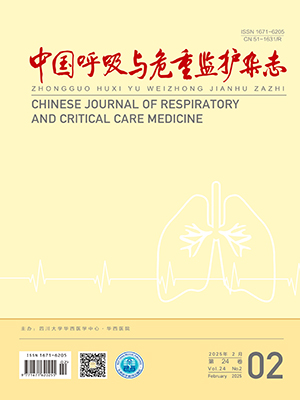| 1. |
GBD 2015 Chronic Respiratory Disease Collaborators. Global, regional, and national deaths, prevalence, disability-adjusted life years, and years lived with disability for chronic obstructive pulmonary disease and asthma, 1990-2015: a systematic analysis for the Global Burden of Disease Study 2015. Lancet Respir Med, 2017, 5(9): 691-706.
|
| 2. |
GBD Chronic Respiratory Disease Collaborators. Prevalence and attributable health burden of chronic respiratory diseases, 1990-2017: a systematic analysis for the Global Burden of Disease Study 2017. Lancet Respir Med, 2020, 8(6): 585-596.
|
| 3. |
GBD 2019 Diseases and Injuries Collaborators. Global burden of 369 diseases and injuries in 204 countries and territories, 1990-2019: a systematic analysis for the Global Burden of Disease Study 2019. Lancet, 2020, 396(10258): 1204-1222.
|
| 4. |
中国医学装备协会呼吸病学专委会吸入治疗与呼吸康复学组, 中国慢性阻塞性肺疾病联盟. 稳定期慢性气道疾病吸入装置规范应用中国专家共识. 中华结核和呼吸杂志, 2019, 42(4): 241-253.
|
| 5. |
中华医学会呼吸病学分会哮喘学组. 支气管哮喘防治指南(2020年版). 中华结核和呼吸杂志, 2020, 43(12): 1023-1048.
|
| 6. |
Vogelmeier CF, Criner GJ, Martinez FJ, et al. Global Strategy for the Diagnosis, Management, and Prevention of Chronic Obstructive Lung Disease 2017 Report. GOLD Executive Summary. Am J Respir Crit Care Med, 2017, 195(5): 557-582.
|
| 7. |
van der Palen J. Peak inspiratory flow through Diskus and Turbuhaler, measured by means of a peak inspiratory flow meter (In-Check DIAL®). Respir Med, 2003, 97(3): 285-289.
|
| 8. |
Chrystyn H. Is inhalation rate important for a dry powder inhaler? Using the In-Check Dial to identify these rates. Respir Med, 2003, 97(2): 181-187.
|
| 9. |
Broeders ME, Molema J, Vermue NA, et al. In Check Dial: accuracy for Diskus and Turbuhaler. Int J Pharm, 2003, 252(1-2): 275-280.
|
| 10. |
Amirav I, Newhouse MT, Mansour Y. Measurement of peak inspiratory flow with in-check dial device to simulate low-resistance (Diskus) and high-resistance (Turbohaler) dry powder inhalers in children with asthma. Pediatr Pulmonol, 2005, 39(5): 447-451.
|
| 11. |
高怡, 黄思琪, 周伟良, 等. 慢性阻塞性肺疾病患者使用干粉吸入器的吸气能力. 广东医学, 2014, 35(19): 3002-3006.
|
| 12. |
Sanders MJ. Guiding inspiratory flow: development of the In-Check DIAL G16, a tool for improving inhaler technique. Pulm Med, 2017, 2017: 1495867.
|
| 13. |
Ghosh S, Pleasants RA, Ohar JA, et al. Prevalence and factors associated with suboptimal peak inspiratory flow rates in COPD. Int J Chron Obstruct Pulmon Dis, 2019, 14: 585-595.
|
| 14. |
Jõgi R, Mattila L, Vahteristo M, et al. Inspiratory flow parameters through dry powder inhalers in healthy volunteers and patients with chronic obstructive pulmonary disease (COPD): device resistance does not limit use in COPD. Int J Chron Obstruct Pulmon Dis, 2021, 16: 1193-1201.
|
| 15. |
Al-Showair RA, Pearson SB, Chrystyn H. The potential of a 2Tone Trainer to help patients use their metered-dose inhalers. Chest, 2007, 131(6): 1776-1782.
|
| 16. |
Blum E, Thavarajah K, Martirosov AL. Optimization of patient-specific inhaler regimens with the use of the aerosol inhalation monitor. J Am Pharm Assoc (2003), 2019, 59(2): 252-257.
|
| 17. |
Branco Ferreira M, Santos A, Clode MH, et al. Turbutest™ in the training of asthmatic Turbuhaler™ users. Allergy, 1999, 54(4): 375-379.
|
| 18. |
Simmons MS, Nides MA, Kleerup EC, et al. Validation of the Doser, a new device for monitoring metered-dose inhaler use. J Allergy Clin Immunol, 1998, 102(3): 409-413.
|
| 19. |
O'Connor SL, Bender BG, Gavin-Devitt LA, et al. Measuring adherence with the Doser CT in children with asthma. J Asthma, 2004, 41(6): 663-670.
|
| 20. |
Julius SM, Sherman JM, Hendeles L. Accuracy of three electronic monitors for metered-dose inhalers. Chest, 2002, 121(3): 871-876.
|
| 21. |
Dynamics F. Mag-Flo Inhaler Trainer [EB/OL]. https://www.fyne-dynamics.com/magflo_inhaler_trainer.htm.
|
| 22. |
D'Arcy S, MacHale E, Seheult J, et al. A method to assess adherence in inhaler use through analysis of acoustic recordings of inhaler events. PLoS One, 2014, 9(6): e98701.
|
| 23. |
Taylor TE, Lacalle Muls H, Costello RW, et al. Estimation of inhalation flow profile using audio-based methods to assess inhaler medication adherence. PLoS One, 2018, 13(1): e0191330.
|
| 24. |
McNulty J, Reilly RB, Taylor TE, et al. Automatic Audio-Based Classification of Patient Inhaler Use: A Pharmacy Based Study. Annu Int Conf IEEE Eng Med Biol Soc, 2019, 2019: 2606-2609.
|
| 25. |
Hesso I, Nabhani Gebara S, Greene G, et al. A quantitative evaluation of adherence and inhalation technique among respiratory patients: An observational study using an electronic inhaler assessment device. Int J Clin Pract, 2020, 74(2): e13437.
|
| 26. |
Ditcham W, Murdzoska J, Zhang G, et al. Lung deposition of 99mTc-radiolabeled albuterol delivered through a pressurized metered dose inhaler and spacer with facemask or mouthpiece in children with asthma. J Aerosol Med Pulm Drug Deliv, 2014, 27 Suppl 1: S63-S75.
|
| 27. |
Foster JM, Smith L, Usherwood T, et al. The reliability and patient acceptability of the SmartTrack device: a new electronic monitor and reminder device for metered dose inhalers. J Asthma, 2012, 49(6): 657-662.
|
| 28. |
Chan AHY, Stewart AW, Harrison J, et al. The effect of an electronic monitoring device with audiovisual reminder function on adherence to inhaled corticosteroids and school attendance in children with asthma: a randomised controlled trial. Lancet Respir Med, 2015, 3(3): 210-219.
|
| 29. |
Foster JM, Usherwood T, Smith L, et al. Inhaler reminders improve adherence with controller treatment in primary care patients with asthma. J Allergy Clin Immunol, 2014, 134(6): 1260-1268.
|
| 30. |
Barrett M, Combs V, Su JG, et al. AIR Louisville: Addressing Asthma With Technology, Crowdsourcing, Cross-Sector Collaboration, And Policy. Health Aff (Millwood), 2018, 37(4): 525-534.
|
| 31. |
Pilcher J, Shirtcliffe P, Patel M, et al. Three-month validation of a turbuhaler electronic monitoring device: implications for asthma clinical trial use. BMJ Open Respir Res, 2015, 2(1): e000097.7.
|
| 32. |
Pilcher J, Holliday M, Ebmeier S, et al. Validation of a metered dose inhaler electronic monitoring device: implications for asthma clinical trial use. BMJ Open Respir Res, 2016, 3(1): e000128.
|




